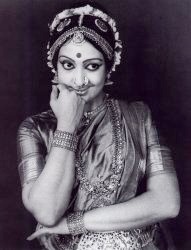
|
 |

|
 |
Karanas - Padma Subrahmanyam, Chennai e-mail: kannanveena@hotmail.com (Courtesy: Natya Kala Conference 2004) December 24, 2004  Hasta pada samayogaha nrittasya karanam bhavet - i.e. the combined movements of hands and feet in dance, is called Karana. Bharatamuni describes its origin and technique in the 4th chapter of ‘Natya Sastra,' which is easily the oldest extant text on Dramaturgy, Dance, Music and Poetics. Each Karana is made up of a Sthana, Chari and Nritta Hasta. The entire gamut of Angika Abhinaya starting from the usage of major and minor limbs needs to be mastered, to learn the Karanas. 108 Karanas have been described by Bharatamuni. Bharata's Sutras are too short for a practical re-construction of these Karanas. Abhinavagupta's commentary, belonging to the early 11th century from Kashmir, illuminates us on their performances. The sculptural sources for the re-construction of the Karanas are from: 1.Brahadiswara temple, Tanjavur 2. Sarangapani temple, Kumbakonam 3. Nataraja temple, Chidambaram They are also found in Arunachaleswarar temple, Tiruvannamalai and Vriddhagireeswarar temple, Vrudachalam - all in Tamil Nadu. Karanas are actions and not static poses. The sculptures are frozen moments of the movements. Pujyashri Kanchi Mahaswami ordered me to design a new set of Karanas for the Uttara Chidambaram Nataraja Mandir, which was being newly built at Satara in Maharashtra. I have designed 108 twin figures of Siva and Parvati suggesting animation. The relevant couplets defining each Karana from Natya Sastra have also been inscribed in granite. My recent discoveries of 52 Karana sculptures from Central Java belonging to the 9th century, has been another breakthrough. The comparison of these with my designs for Satara and my practical re-construction of the Karanas have revealed an amazing oneness. Dr. Alessandra Iyer of London has written a detailed book on this connection and this book is published from Thailand. It has been almost a mystic experience for me. It proves the following: 1. I have been a humble instrument in the holy hands of the Sage of Kanchi in bringing to light, this link beyond time and space. 2. The Prambanan-Satara link has proved beyond doubt the authenticity of my re-construction of the Karanas. 3. ‘Natya Sastra has been a common text not only for the Bharata Khanda (Indian sub-continent) but also for the whole of Bharata Varsha (South East Asia). Detailed information can be obtained from my book ‘Karanas - Common Dance Codes of India and Indonesia' - Three volumes published by Nrityodaya, Chennai. Padma Subrahmanyam is acclaimed as a rare combination of a dancer, research scholar, choreographer, music composer, teacher, author and Indologist. She is the director of Nrityodaya, school of dance and music. She was awarded a PhD for her pioneering work on Karanas in Indian Dance and Sculpture. She has numerous articles and research papers and books to her credit. |